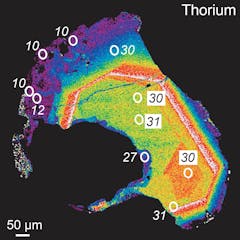
Articles on Rocks
Displaying 1 - 20 of 29 articles

Life depends on Earth’s ancient continental crust – but there are only a few places where remnants of it can still be seen today.

Measuring the concentration of radioactive elements in a single, sand-size crystal reveals the growth of the Himalayan mountain range over time.

There are a lot of myths about crystals − for example, that they are magical rocks with healing powers. An earth scientist explains some of their amazing true science.

Mineralogical analysis of 5,000-year-old stone beads from Turkana, Kenya suggest a novel mortuary tradition by early pastoralists.

Some rocks will burn, and others will melt, depending on how they were formed and what minerals they contain.

Sophisticated equipment on the Perseverance rover is helping answer some of the many questions researchers have about Mars’ geology over time.

Without intervention, the rock may have been destroyed by high tides and storm surges.

A biologist explains how researchers nail down the age of ancient fossils thanks to a physical process called radioactive decay.

Crystals are part of a larger tradition of metaphysical religions that have a long history in the U.S.

Dating of rocks that once formed some of the world’s first beaches suggests the first large continents grew large enough to rise above sea level roughly 3 billion or so years ago.

Perseverance and its helicopter sidekick, Ingenuity, have been on Mars for nearly nine months. The duo have taken rock samples, performed first flights and taken images of the delta in Jezero Crater.

When borders reopen, take an Aussie road trip and explore the continent’s unique geology, from meteorites in the Nullarbor Plain to rock formations that are billions of years old.

Researchers used decades-old radar data and found that some low-lying areas of Venus’ crust are moving and jostling. This evidence is some of the strongest yet of tectonic activity on Venus.

The presence of water on the Earth’s surface is the result of a subtle balance between different mechanisms in the atmosphere and below the surface.

Earth’s magnetic field locks information into lava as it cools into rock. Millions of years later, scientists can decipher this magnetic data to build geologic timelines and maps.

To avoid global warming on a catastrophic scale, nations need to reduce emissions and find ways to pull carbon from the air. One promising solution: spreading rock dust on farm fields.

There are memorial stones scattered along songlines throughout the Australian landscape, victims and transgressors transformed into rock following epic struggles to stand as cautionary tales.

As strange as it sounds, rocks are made from stardust.

Researchers can more easily compare heated rocks from different studies and areas.

Trackways made by vertebrates during the Pleistocene era, dating back to between 36 000 and 140 000 years helps with research into ancient animals.
